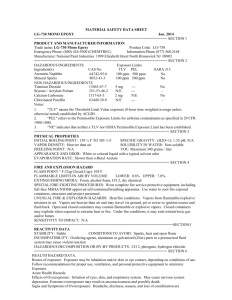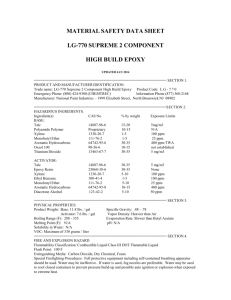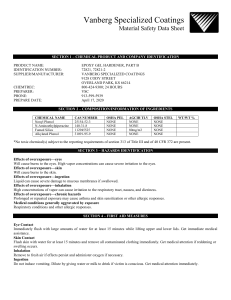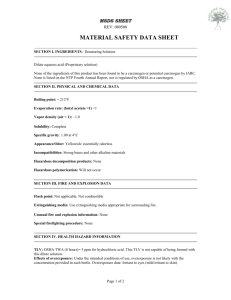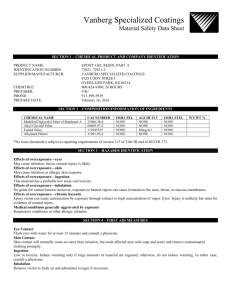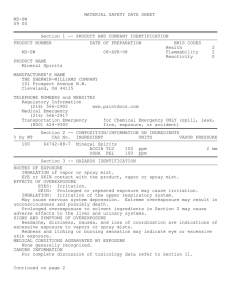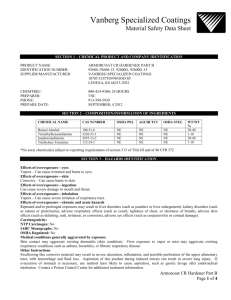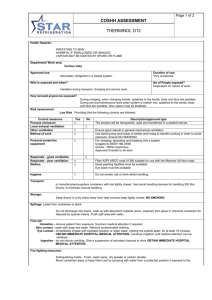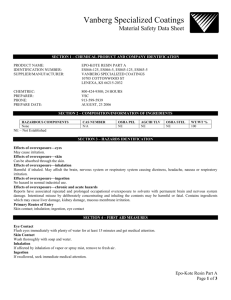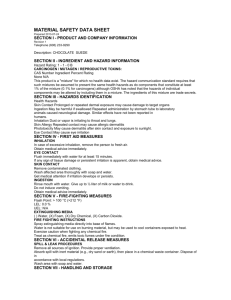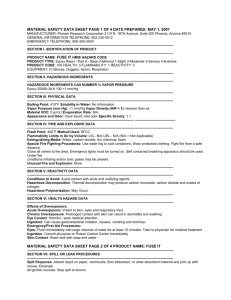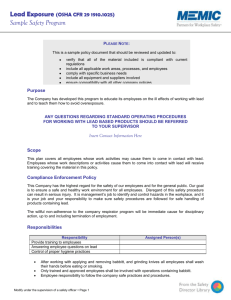MSDS
advertisement
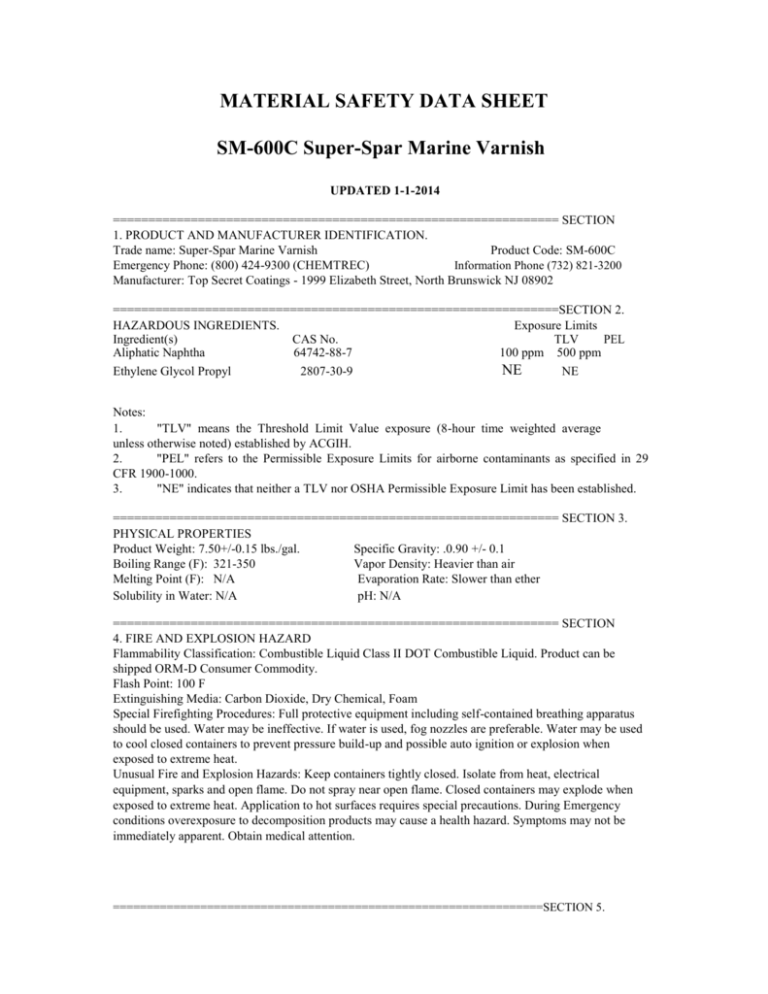
MATERIAL SAFETY DATA SHEET SM-600C Super-Spar Marine Varnish UPDATED 1-1-2014 =============================================================== SECTION 1. PRODUCT AND MANUFACTURER IDENTIFICATION. Trade name: Super-Spar Marine Varnish Product Code: SM-600C Emergency Phone: (800) 424-9300 (CHEMTREC) Information Phone (732) 821-3200 Manufacturer: Top Secret Coatings - 1999 Elizabeth Street, North Brunswick NJ 08902 ===============================================================SECTION 2. HAZARDOUS INGREDIENTS. Exposure Limits Ingredient(s) CAS No. TLV PEL Aliphatic Naphtha 64742-88-7 100 ppm 500 ppm Ethylene Glycol Propyl 2807-30-9 NE NE Notes: 1. "TLV" means the Threshold Limit Value exposure (8-hour time weighted average unless otherwise noted) established by ACGIH. 2. "PEL" refers to the Permissible Exposure Limits for airborne contaminants as specified in 29 CFR 1900-1000. 3. "NE" indicates that neither a TLV nor OSHA Permissible Exposure Limit has been established. =============================================================== SECTION 3. PHYSICAL PROPERTIES Product Weight: 7.50+/-0.15 lbs./gal. Specific Gravity: .0.90 +/- 0.1 Boiling Range (F): 321-350 Vapor Density: Heavier than air Melting Point (F): N/A Evaporation Rate: Slower than ether Solubility in Water: N/A pH: N/A =============================================================== SECTION 4. FIRE AND EXPLOSION HAZARD Flammability Classification: Combustible Liquid Class II DOT Combustible Liquid. Product can be shipped ORM-D Consumer Commodity. Flash Point: 100 F Extinguishing Media: Carbon Dioxide, Dry Chemical, Foam Special Firefighting Procedures: Full protective equipment including self-contained breathing apparatus should be used. Water may be ineffective. If water is used, fog nozzles are preferable. Water may be used to cool closed containers to prevent pressure build-up and possible auto ignition or explosion when exposed to extreme heat. Unusual Fire and Explosion Hazards: Keep containers tightly closed. Isolate from heat, electrical equipment, sparks and open flame. Do not spray near open flame. Closed containers may explode when exposed to extreme heat. Application to hot surfaces requires special precautions. During Emergency conditions overexposure to decomposition products may cause a health hazard. Symptoms may not be immediately apparent. Obtain medical attention. ================================================================SECTION 5. HEALTH HAZARD DATA. Routes of exposure: Exposure may be inhalation and/or skin or eye contact, depending on conditions of use. Follow recommendations for proper use, ventilation, and personal protective equipment to minimize Exposure. Acute Health Hazards: Effects of Overexposure: Irritation of eyes, skin, and respiratory system. May cause nervous system depression. Extreme overexposure may result in unconsciousness and possibly death. Signs and Symptoms of Overexposure: Headache, dizziness, nausea, and loss of coordination are Indications of excessive exposure to vapors and spray mists. Redness and itching or burning sensation may indicate eye or excessive skin exposure. Emergency and First Aid Procedures: Eyes: Flush eyes with large amounts of water for 15 minutes while holding eyelids open. Get medical attention. Skin: Immediately remove contaminated clothing, and wash with plenty of soap and water. Get medical attention if symptoms persist. Inhalation: Remove patient to fresh air. Administer oxygen if breathing is difficult. Keep warm and quiet. Get medical attention. Ingestion: Do not induce vomiting. Give patient milk or water to dilute. Immediately consult physician. Medical Conditions Aggravated by Exposure: None generally recognized. Chronic Health Hazards: Prolonged overexposure to solvent ingredients in section II may cause adverse effects to the liver, urinary, blood forming, cardiovascular, and reproductive systems. Reports have associated repeated and prolonged overexposure to solvents with permanent brain and nervous system damage. ============================================================== SECTION 6. REACTIVITY DATA. Stability: Stable. Conditions to avoid: Keep containers closed at all times. Incompatibility: Contamination with water, acids, or alkalis can cause evolution of hydrogen, which may result in dangerously increased pressures in closed containers. Hazards Decomposition Products: Carbon monoxide and/or carbon dioxide. Hazardous Polymerization: Will not occur. ============================================================= SECTION 7. SPILL OR LEAK PROCEDURES. Steps to be taken in case material is released or spilled. Remove all sources of ignition. Ventilate and remove with inert absorbent. Waste Disposal Method Waste from this product may be hazardous as defined under the Resource Conservation and Recovery Act (RCRA), 42 U.S.C. section 6901 et seq., and regulations there under, 40 C.F.R. Part 261. Dispose of in accordance with applicable federal, state and local regulations. =============================================================SECTION 8. PROTECTION INFORMATION. Use only with adequate ventilation. Avoid breathing vapor and spray mist. Avoid contact with skin and eyes. Wash hands after using. Ventilation. Local exhaust preferable. General exhaust acceptable if the exposure to materials in section II is maintained below applicable exposure limits. Refer to OSHA standards 1910.94, 1910.107, and 1910.108. Respiratory Protection. If personal exposure cannot be controlled ventilation, wear properly fitted organic vapor/particulate respirator approved by NIOSH/MSHA for protection from materials in section II. Protective Gloves. Wear gloves, which are recommended by glove supplier for protection against materials in Section II. Eye Protection. Wear safety spectacles with imperforated side shields. ==============================================================SECTION 9. PRECAUTIONS. Precautions to be taken in Handling and Storing. Keep away from heat, sparks, and open flame. During use and until all vapors are gone: keep area ventilated -- DO NOT SMOKE -- extinguish all flames, pilot lights and heaters -- turn off stoves, electric tools and appliances, and any other source of ignition. Consult NFPA code. Use approved bonding and grounding procedures. Keep container closed when not in use. Transfer only to approved containers with complete and appropriate labeling. Do not take internally. Keep out of the reach of children. The above information pertains to this product as currently formulated, and is based on the information available at this time. Addition of reducers or other additives to this product may substantially alter the composition and hazards of the product. Since conditions of use are outside our control, we make no warranties, expressed or implied, and assume no liability in connection with any use of this information.
